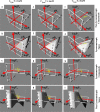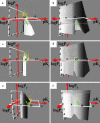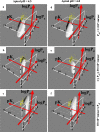Simulation-based cheminformatic analysis of organelle-targeted molecules: lysosomotropic monobasic amines
- PMID: 18338229
- PMCID: PMC2516532
- DOI: 10.1007/s10822-008-9194-7
Simulation-based cheminformatic analysis of organelle-targeted molecules: lysosomotropic monobasic amines
Abstract
Cell-based molecular transport simulations are being developed to facilitate exploratory cheminformatic analysis of virtual libraries of small drug-like molecules. For this purpose, mathematical models of single cells are built from equations capturing the transport of small molecules across membranes. In turn, physicochemical properties of small molecules can be used as input to simulate intracellular drug distribution, through time. Here, with mathematical equations and biological parameters adjusted so as to mimic a leukocyte in the blood, simulations were performed to analyze steady state, relative accumulation of small molecules in lysosomes, mitochondria, and cytosol of this target cell, in the presence of a homogenous extracellular drug concentration. Similarly, with equations and parameters set to mimic an intestinal epithelial cell, simulations were also performed to analyze steady state, relative distribution and transcellular permeability in this non-target cell, in the presence of an apical-to-basolateral concentration gradient. With a test set of ninety-nine monobasic amines gathered from the scientific literature, simulation results helped analyze relationships between the chemical diversity of these molecules and their intracellular distributions.
Figures







Similar articles
-
A cell-based molecular transport simulator for pharmacokinetic prediction and cheminformatic exploration.Mol Pharm. 2006 Nov-Dec;3(6):704-16. doi: 10.1021/mp060046k. Mol Pharm. 2006. PMID: 17140258 Free PMC article.
-
Amine-containing molecules and the induction of an expanded lysosomal volume phenotype: a structure-activity relationship study.J Pharm Sci. 2014 May;103(5):1572-80. doi: 10.1002/jps.23949. Epub 2014 Mar 19. J Pharm Sci. 2014. PMID: 24647827
-
Modeling and Simulation of Intracellular Drug Transport and Disposition Pathways with Virtual Cell.J Pharm Pharmacol (Los Angel). 2013 Sep 13;1(1):1000004. doi: 10.13188/2327-204X.1000004. J Pharm Pharmacol (Los Angel). 2013. PMID: 24364041 Free PMC article.
-
Cancer therapy: Targeting mitochondria and other sub-cellular organelles.Curr Pharm Des. 2014;20(2):201-22. doi: 10.2174/13816128113199990031. Curr Pharm Des. 2014. PMID: 23701545 Review.
-
A network of interorganellar communications underlies cellular aging.IUBMB Life. 2013 Aug;65(8):665-74. doi: 10.1002/iub.1183. Epub 2013 Jul 2. IUBMB Life. 2013. PMID: 23818261 Review.
Cited by
-
A cell-based computational modeling approach for developing site-directed molecular probes.PLoS Comput Biol. 2012;8(2):e1002378. doi: 10.1371/journal.pcbi.1002378. Epub 2012 Feb 23. PLoS Comput Biol. 2012. PMID: 22383866 Free PMC article.
-
Mechanisms of amine accumulation in, and egress from, lysosomes.Bioanalysis. 2009 Nov;1(8):1445-59. doi: 10.4155/bio.09.128. Bioanalysis. 2009. PMID: 21083094 Free PMC article. Review.
-
Cell-based multiscale computational modeling of small molecule absorption and retention in the lungs.Pharm Res. 2010 Mar;27(3):457-67. doi: 10.1007/s11095-009-0034-9. Epub 2010 Jan 23. Pharm Res. 2010. PMID: 20099073 Free PMC article.
-
Quantifying lysosomal glycosidase activity within cells using bis-acetal substrates.Nat Chem Biol. 2022 Mar;18(3):332-341. doi: 10.1038/s41589-021-00960-x. Epub 2022 Feb 24. Nat Chem Biol. 2022. PMID: 35210619
-
The subcellular distribution of small molecules: from pharmacokinetics to synthetic biology.Mol Pharm. 2011 Oct 3;8(5):1619-28. doi: 10.1021/mp200092v. Epub 2011 Aug 15. Mol Pharm. 2011. PMID: 21805990 Free PMC article. Review.
References
-
- Reasor MJ, Kacew S. Exp Biol Med (Maywood) 2001;226:825–830. - PubMed
Publication types
MeSH terms
Substances
Grants and funding
LinkOut - more resources
Full Text Sources

